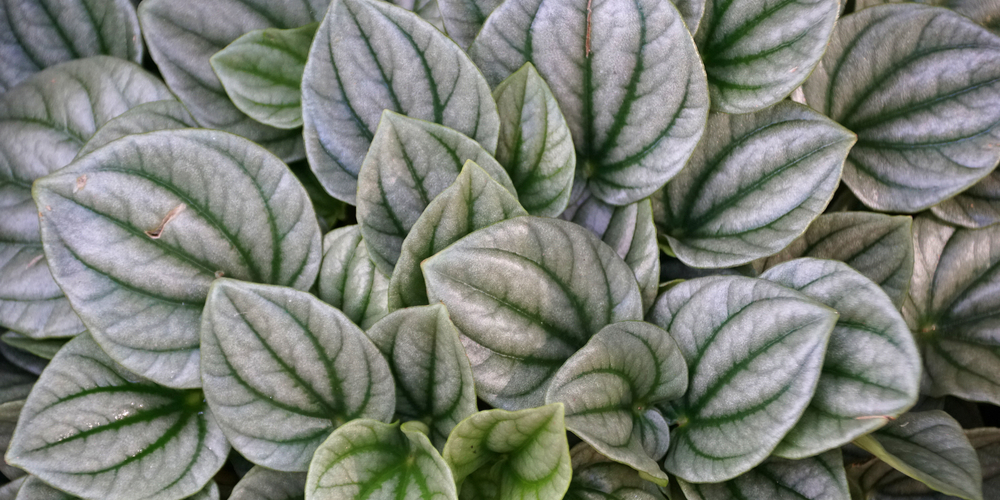Peperomia Frost (scientific name: Peperomia Caperata), also called Silver Frost, is a lovely perennial native to South American rainforests. The “frost” adjective refers to their tolerance to the cool temperature of the forests’ understory. To learn more about this attractive plant and how to care to make it thrive in your house, keep reading. In this essential guide, you’ll learn all you need to know to provide your Peperomia frost with all it needs.
What you Need to Know About Peperomia Frost

This variety of peperomia produces dense and thick heart-shaped silver leaves with dark green marketing along the veins. Despite its fleshy leaves, this plant is not succulent. Instead, it is a tropical perennial that requires high levels of humidity.
Many homeowners like this plant for the easiness it grows indoors. Because of its dense foliage, peperomia frost can add a splash of colors to any corner of your house. The plant produces spiky flowers without a fragrance: peperomia’s highlight is its bright leaves. If you have kids or pets, don’t worry about having them munching on it: this plant is not toxic to either humans or animals. Despite being a relatively low-maintenance plant, you’ll want to learn about its needs to ensure you provide it with all it requires for thriving. Jump to the next section to discover how to grow Peperomia.
Care Requirements
While not particularly needy, you’ll still have to pay attention that your Peperomia receives what it needs. To make it thrive, you have to ensure it will get an adequate amount of light, moderate humidity, and frequent watering. For more details, read the following sections.
Light
Peperomia frost thrives under indirect light. Place it under a window facing east or south for best results. Consider adding some sheer curtains to protect your plant’s leaves from sunburn. If you can’t provide it with full sun all day long, don’t worry. Your peperomia will also grow under moderate sources of light, but its growth might be slower.
Water and Soil Needs
Overwatering might be an issue with this tropical plant. This plant tolerates drought quite well but might struggle to survive in soggy soil. Make sure you check the soil conditions before adding more water. If by pushing your fingers deep they come out dry, it is time to water your plant. If you want to be more precise, add water when the top 50 to 75% is dry. If you follow this rule, you’ll notice that your plant needs less water during the winter. Reduce the frequency to prevent overwatering.
Place your peperomia in well-drained soil inside a pot with drainage holes. Water your plant until the excess flows out. Remove the stagnant water from the bottom to prevent root rot.
Peperomia likes airy and well-drained soils. You can create the ideal conditions by mixing one part of perlite and two parts of peat. Alternatively, add potting mix, orchid bark, and sand to equal ratios. Despite what you may think, these plants do better without much root space: choose a shallow pot over a deep one.
Temperature Requirements
These tropical plants thrive at temperatures between 65 and 75F. Don’t expose them to colder conditions and protect them below 50F. Under adequate conditions, they will grow without problems even in the colder regions, provided that you ensure a consistent environment. Don’t place them next to a window if the outdoor temperatures are too low.
Also, if you feel your house might be too dry, consider getting a humidifier. Alternatively, mist your peperomia leaves with water or use a pebble tray to retain moisture.
What USDA climate zone can it survive?
You can grow Peperomia frosts indoors in most USDA hardiness zones. However, if you are thinking about planting it outdoors, you can only do it in zones between 10 and 12. Protect them from harsh winds and consider getting them inside if the temperatures get cold.
Fertilizer
While these plants are not heavy feeders, you’ll still need to provide them with additional nutrients to ensure their healthy growth. Select a slow-releasing fertilizer during the summer month. To prevent overfertilization, consider diluting your liquid product to half the strength and stop fertilization during the winter. You can safely use an all-purpose houseplant fertilizer. Make sure you check the dosage before adding it to your plant.
Common Diseases
Indoors peperomia frosts are not susceptible to many diseases. However, spider mites, scale, and fungus gnat can attack a weak plant and cause damage. Keep an eye out for any problem and take immediate action if you notice something may be off with your plant.
Common Problems
Peperomia frosts are hardy plants. They rarely have problems. But without adequate care, they might show symptoms that signal you are doing something wrong. For instance, too much humidity will cause brown leaves, while inadequate nutrients or excessive light might cause yellowing. Monitor your plant and take appropriate measures to reverse the damage.
Peperomia Frost Propagation
If you like Peperomia, you’ll be happy to hear that propagating them is not a difficult task. The most efficient way to do it is through leaf cuttings. While stem cutting is also common, you’ll get the best results through leaves. Propagate your plant in the spring to ensure your cuttings will grow roots and establish themselves in a new location.
To get new plants, cut a healthy leaf using sterile scissors. To prevent rotting, we recommend letting the leaf for a day and planting the cut in a potting mixture after that. Make sure you create an adequate hole and ensure your cutting firmly to the soil.
Water it thoroughly and place it under indirect light. Keep the soil moist but not wed and mist the leaf every couple of days to ensure it gets adequate humidity. To increase the temperature, consider covering it with a transparent plastic bag. If you follow our recommendations, you’ll see roots in about eight weeks. After that time, you’ll be able to transfer your cutting to another pot to allow it to grow.

